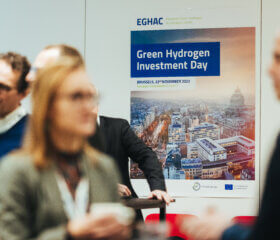
Decarbonize hard to abate industries – EGHAC organized a parallel session during TBB
The Business Booster (TBB) is EIT InnoEnergy’s annual two-day international networking event that showcases 150+ sustainable energy technologies under one roof. Each year, the event rotates among European capital cities, this edition was in Lisbon, next year it will be in Amsterdam on 18-19 October 2023. The European Green Hydrogen Acceleration Center (EGHAC) had the privilege to host one of the parallel sessions on this great event. A panel was brought together with representatives of relevant industrials, technology and infrastructure companies as well as some relevant portfolio companies supported by EGHAC. Together we explored what role green hydrogen and it derivates can play to decarbonize hard to abate industries.
Watch the recording below or here, or read the summary:
Green Hydrogen is a mean, not a goal
Jacob Ruiter, Managing Director of the European Green Hydrogen Acceleration Center (EGHAC) kicked-off the discussions. He made the point that the focus is only on green hydrogen, but also that hydrogen is seen as a mean to decarbonize those hard to abate industry where direct electrification is not possible. EGHAC has 2 main activities, the first one is company building where a new company is created with shareholders of representatives along the complete value chain. With this value chain approach risk and benefits are shared and by that the green premium for the end products can be kept to a minimum. This new company will have an independent management team who has full responsibility and can have focus on the development which is a clear advantage compared to traditional project set-ups. The EGHAC is also providing acceleration services to projects to de-risk and accelerate them. A good example of that is the cooperation with the European Clean Hydrogen Alliance where EGHAC is asked to support a selection of relevant projects from their pipeline.
Integration of hydrogen technology in the overall production process
Elvira Garcia-Marquez who leads the Environment Engineering and technology department of Sener, a Spanish Engineering group deploying key technologies related to green hydrogen and renewables gave her insights on the challenges hydrogen projects face reaching the Final Investment Decision (FID). It is not only the uncertainty of the new technology, and other factors like regulatory, it is also a challenge of integrating the hydrogen technology into the overall production process. Making sure the infrastructure for renewables, but for example also storage is taken care of. At SENER they work with many industries across various geographies, front runners can be found in the refining industry, chemicals and fertilizers where fossil hydrogen is being replaced by green hydrogen. Also in heavy transportation and those industries where they need heat above 600 degrees green hydrogen comes into play. Sener is supporting to de-risk these projects by co-development of the required technology and is working together with industry as well as start-ups in the European ecosystem.
Business-to-Decarbonization
Diogo Almeida, head of Hydrogen Business Development at Galp shared the ambition that Galp will gradually fully decarbonize all their own activities. One of the low hanging fruits which is worked on are the refineries. In Sines a first 600MW electrolyser will be built to produce 60.000 tons of green hydrogen replacing the fossil hydrogen currently used. On top of this they want to support their customers decarbonizing their production processes and products. What can be electrified should be electrified, but green hydrogen and it derivates like ammonia, methanol and sustainable aviation fuels will play an important role. With the European regulations, Fit for 55, ETS and CBAM coming in place as well as the increased willingness to pay a small premium for greener produced products Diogo is confident that the required steps will be taken. Galp is transitioning into a zero-carbon energy integrated company and they no longer only speak about B-2-C or B-2-B but about B-2-D nowadays; Business-to-Decarbonization.
Green hydrogen as business opportunity
Diogo Mendes, Technology Director at Bondalti Chemicals started with giving insights in the role they play as chemical company in often very long value chains. Hydrogen and ammonia is used to produce Aniline, which serves as ingredient for many day-to-day products like shoes, matrasses, insulation and a variety of panels for the automotive industry. They consumer 45000 ton of grey ammonia, mainly imported from Northern-Africa. The hydrogen comes for 20% from chlorine electrolysis and 80% they buy from fossil sources. Together this accounts for roughly 150.000 tons of CO2 equivalent, and therefore decarbonization is a high priority. The main pressure to become greener is coming from strong regulations like fit for 55 which requires companies using hydrogen to replace at least 50% of that by renewable hydrogen by 2030. On top of Bondalti sees an increased pressure in the automotive and construction industries to lower the carbon footprint of the products used. The willingness to pay a green premium is still limited in these cost driven value chains. The ambition to decarbonize the production also creates new business opportunities, a great example is a recent started project where Bondalti is producing green methanol with biogenic CO2 and green hydrogen, opening up a new customer base.
Form a storage company to a conversion company
Rob Penne, Head of Hydrogen and Decarbonization at VTTI elaborated on the role imports could play. Looking at the intermittent nature of renewables used to produce the green hydrogen locally, imports are complementary to fill the gaps. In Europe most of the renewables will be used for direct electrification and that will also further increase the need for imports to have enough green hydrogen available. Existing infrastructure for imports is already suitable for methanol, and with some extra jetties ammonia would also not be a huge problem. Importing hydrogen would however require much more investments still in a proper backbone and storage in for example caverns, but also getting it to the final off-taker requires new solutions for fine distribution. In terms of economics importing ammonia for usage as ammonia is cost effective, using it for the hydrogen is probably at par or a bit more expensive. The expectation is that efficiency gains in ammonia cracking will improve the business case for importing hydrogen substantially. Front runners for import can be found in the ARA region (Amsterdam, Rotterdam, Antwerp), Northern-Germany and the United Kingdom. The ambition of VTTI is to develop itself from a storage company to a conversion company, converting in various stages in the supply chain electrons to hydrogen, hydrogen to carriers and derivates and vice-versa.
An integrated value chain approach
Jean Pierre Riche, President and founder of pHYnix, oneof the first independent producers of green hydrogen in Europe shared how they approach green hydrogen initiatives. They are active with applications for industrial heat, injecting hydrogen into the grid and heavy mobility. Three main aspects should always be considered. First of all it starts with he off-takers, you need a drive from someone really wanting to decarbonize, for heavy mobility it will be the industrial production companies in most cases. Secondly you have to consider the Total Cost of Ownership, not only look at the price of hydrogen but also take into account the vehicles needed or value created by having for example better access to capital by being a greener company. And lastly it requires an integrated value chain, trucks and refueling stations have to be available and developed parallel to the green hydrogen itself. pHYnix is supporting the market development and is a member of the retrofit coalition, a French cooperation of off-takers, transport companies, retrofitters, financiers and policymakers to increase the number of retrofit trucks. This will overcome the hen and egg discussion in the industry and with the ambition to have 10.000 vehicles ready by 2030, boost the use of green hydrogen for heavy mobility.
GravitHy, decarbonization in action
Jose Noldin, CEO of GravitHy, the worlds first green iron company, stated that decarbonizing the steel industry is not a matter of possibility, it is a pure necessity. Steel is an essential part in many products and is all around us. This scale is one of the reasons that steel accounts for 7-10% of the global CO2 emissions. GravitHy focusses both on technology innovation as well redefining business models. The 2 million tons of green iron (DRI) can be used by existing steelmakers creating a new green commodity and enabling existing steelmaker to decarbonize as well. GravitHy is founded by 6 companies, representing the complete value chain and bringing in their specific expertise. The EGHAC has started this initiative and provides de-risking and acceleration services, renewables expertise is brought in by Engie and the technology for 2 main components are the expertise of Plug for the electrolysers and Primetals for iron production. Important is also the off-taker perspective which in this case is represented by Forvia. This approach will set-up GravitHy for success and contribute to the decarbonization of the overall steel industry.
Not a silver bullet
The panelist gave a broad and diverse insight in the role which green hydrogen can play in hard to abate industries. We can conclude that it will not be a silver bullet which will solve all challenges in one go, but it does provide the opportunity for decarbonization and creates new business opportunities as well. A cooperative, holistic approach focusing on technology and business model innovation with representatives of the complete value chain including off-takers will offer the best chance for success!




